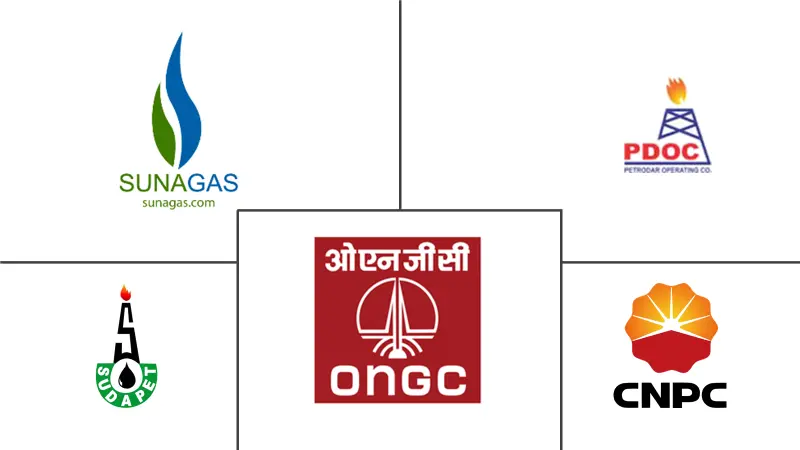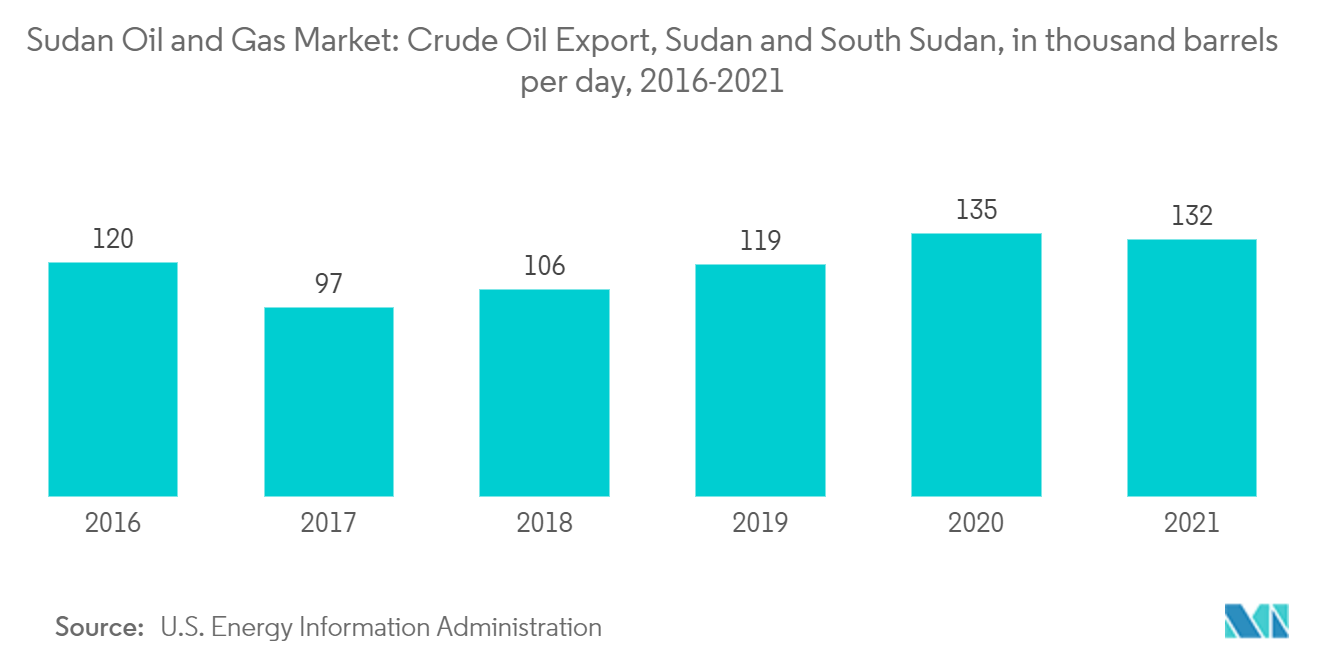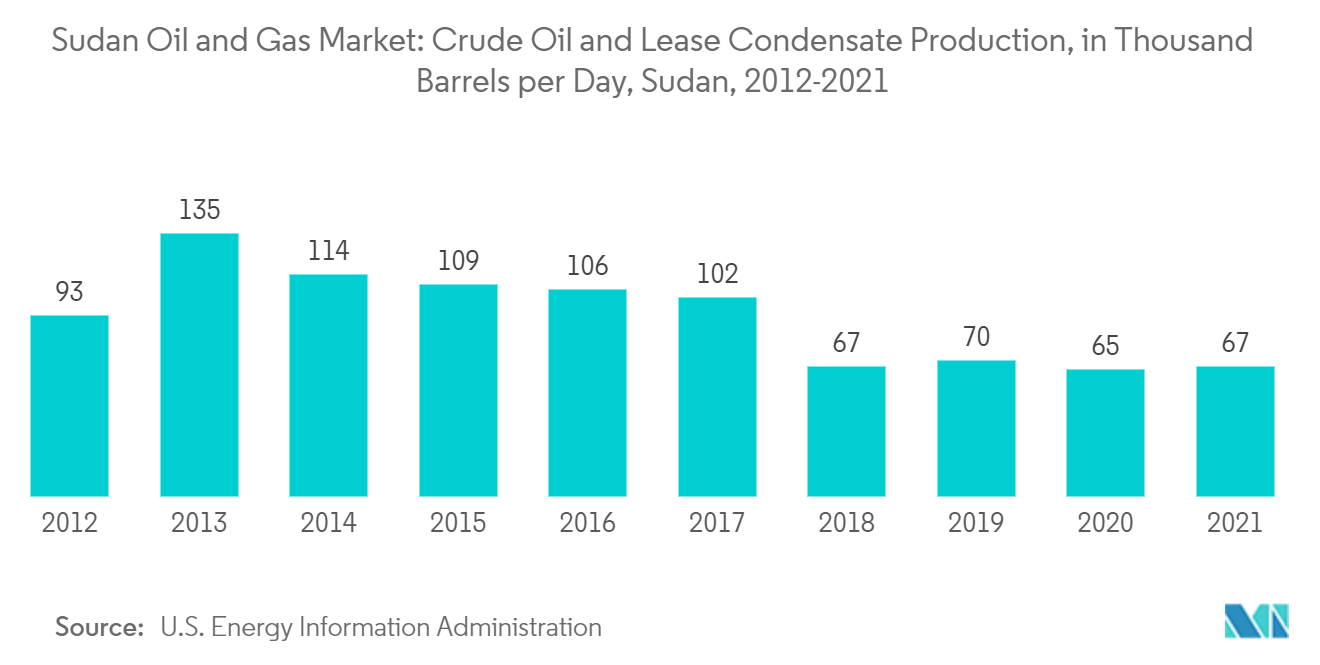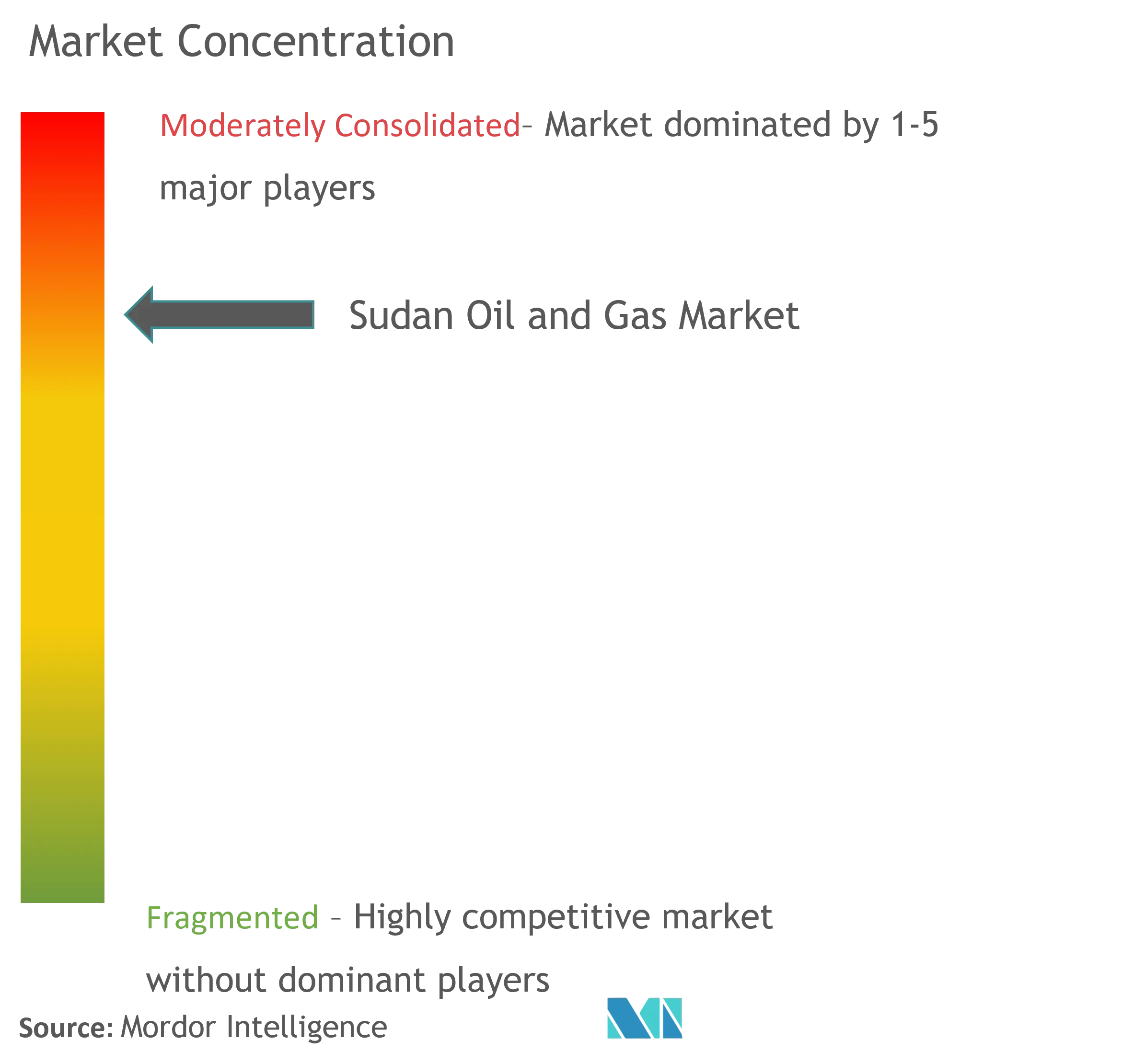Sudan Oil and Gas Market Analysis
The Sudan Oil and Gas Market is expected to register a CAGR of less than 1.5% during the forecast period.
The market was negatively impacted by COVID-19. Presently the market has now reached pre-pandemic levels.
- Over the medium term, investment in the oil and gas market is expected to be the main driver in the forecast period. The increase in growth is expected to be majorly in the downstream and midstream sector.
- On the other hand, the production level of the oil fields is reducing in the 2015 - 2021 period, and it is expected to decrease further in the forecast period and thereby impede growth in the market.
- Nevertheless, the country is trying to increase production through the use of enhanced oil recovery (EOR) to increase the production, any breakthrough in the increase in output can become an opportunity for the companies in the market
Sudan Oil and Gas Market Trends
Midstream Sector to Witness Significant Growth
- The midstream sector pertains to the transport and storage of crude oil and natural gas extracted and includes infrastructure such as crude oil and natural gas pipelines, gas treatment plants, natural gas liquefaction plants, and liquefied gas and regasification storage.
- In Sudan, two major export pipelines transport crude oil from the Palogue and Adar Yale oil fields in the Melut Basin (Blocks 3E and 7E) to the Marsa al-Bashair (or Bashayer Marine) Terminal, located approximately 15 miles south of Port Sudan. Adar Yale oil fields (Blocks 3E and 7E) are transported via the Petrodar (PDOC) pipeline to Port Sudan's Bashayer Marine Terminal through the Petrodar (PDOC) pipeline. These fields produce a blend of crude oil known as the Dar blend, which is transported for export via the pipeline.
- Using the GNPOC pipeline, crude oil from Sudan's Heglig oil field and South Sudan's Thar Jath, Unity, and Mala oil fields (Blocks 1 and 5A) are transported to the Bashayer Marine Terminal in Port Sudan for export, and to two refineries in El-Obeid and Khartoum for refinement and distribution to the domestic market.
- South Sudan and Sudan have extended their oil deal through to 2022, which allows South Sudan to export its crude through Sudan's ports. The original deal was signed in 2012 and was extended further. Due to South Sudan's secession in 2011, Sudan lost most of its oil wealth. It is keen to continue benefitting from exporting its neighbour's oil through its pipelines and ports on the Red Sea.
- As South Sudan's crude oil production is gradually increasing, as part of its first licensing round in 2021, the government of South Sudan offered five exploration licenses in order to attract a diverse group of foreign investors to stimulate upstream investment and increase crude oil production. The increasing oil prodcution in south sudan is expected to help the midstream sector in Sudan.
- Sudan and South Sudan's annual exports of crude oil reached 132 thousand barrels per day in 2021 with an increase of 10% from 120 thousand barrels per day in 2016.
- Such developments are expected to accelerate the midstream segment in the Sudan's oil and gas market.
Reduced Production in Oil Fields to Restrain the Market
- Since Sudan gained independence in 1956, two civil wars have occurred. The second civil war ended in 2005 and resulted in a Comprehensive Peace Agreement (CPA) between the Sudanese government and rebel factions in the southern region. The CPA established guidelines for oil revenue sharing and a timeframe to hold a referendum for the independence of the South. As a result of the overwhelming vote for secession, South Sudan became an independent nation in July 2011.
- Due to the secession of South Sudan, Sudan's economy was severely affected as 75% of its oil reserves were lost to South Sudan. The oil sectors of Sudan and South Sudan are deeply intertwined and play a vital role in their economies; most of the oil-producing assets are adjacent or extend across their shared borders. Due to continued internal political instability in both Sudan and South Sudan, oil production in Sudan has declined since the split.
- Production of crude oil and lease condensate in the country, decreased by 38.5% from 109 thousand barrels per day, in 2015 to 67 thousand barrels per day, in 2021.
- The country still faces many challenges in procuring investment into its oil and gas industry due to corruption and instability pertaining to the country.
- Sudan's oil sector suffers from years of underinvestment. By introducing improved technology, building staff capacity, and modernizing existing physical plants, the sector's productivity could be improved, and the sector's productive capacity could increase. Sudan's oil and gas sector is controlled by government-owned Sudapet and SudaGas, but the leadership of these companies has been replaced several times since 2019. Furthermore, due to the government's lack of financial resources, it is often unable to pay contractors or purchase new equipment.
- Such conditions in the country like corruption and lack of investments are likely to hinder the growth of the oil and gas market in the coming years.
Sudan Oil and Gas Industry Overview
The Sudan oil and gas upstream market is moderately consolidated. The major companies (in no particular order) include Oil and Natural Gas Corporation, Sudan National Petroleum Corporation, China National Petroleum Corporation, Sunagas, and Petrodar Operating Company.
Sudan Oil and Gas Market Leaders
-
Oil and Natural Gas Corporation
-
Sudan National Petroleum Corporation
-
China National Petroleum Corporation
-
Sunagas
-
Petrodar Operating Company
- *Disclaimer: Major Players sorted in no particular order
Sudan Oil and Gas Market News
- In August 2022, the Russian company Zarubezhneft plans to expand its operations in Sudan, where the government has offered new blocks for oil exploration and production. During the preparation process, Zarubezhneft, in collaboration with Sudan's Energy and Oil Ministry and Sudapec, increased the number of oil blocks that would be developed. As part of the agreement, the companies will discuss extending cooperation beyond production in the oil sector to include technologies related to oil recovery, the use of associated gas, oil refining, petrochemicals, and training.
- In April 2022, Sudan's Minister of Energy and Oil invited Algerian companies, including Sonatrach, to study the investment opportunities in the oil and gas sector. The minister highlighted Sudan's desire to participate in Algeria's gas experience and capacity building.
Sudan Oil and Gas Industry Segmentation
Oil and Gas are defined as petroleum, natural gas, hydrocarbons, minerals, or any combination of them, and all substances developed from them. In the production and distribution of oil and gas, a number of complex processes and systems are employed, which require advanced technology and a large amount of capital. There are three major sectors in the oil and gas industry: upstream, midstream, and downstream. Sudan oil and gas market is segmented by sector. By sector, the market is segmented into upstream, midstream, and downstream. For each segment, the market sizing and forecasts have been done based on revenue (USD Billion).
Sudan Oil and Gas Market Research FAQs
What is the current Sudan Oil and Gas Market size?
The Sudan Oil and Gas Market is projected to register a CAGR of less than 1.5% during the forecast period (2025-2030)
Who are the key players in Sudan Oil and Gas Market?
Oil and Natural Gas Corporation, Sudan National Petroleum Corporation, China National Petroleum Corporation, Sunagas and Petrodar Operating Company are the major companies operating in the Sudan Oil and Gas Market.
What years does this Sudan Oil and Gas Market cover?
The report covers the Sudan Oil and Gas Market historical market size for years: 2021, 2022, 2023 and 2024. The report also forecasts the Sudan Oil and Gas Market size for years: 2025, 2026, 2027, 2028, 2029 and 2030.
Our Best Selling Reports
Oil and Gas in Sudan Industry Report
Statistics for the 2025 Sudan Oil and Gas market share, size and revenue growth rate, created by Mordor Intelligence™ Industry Reports. Sudan Oil and Gas analysis includes a market forecast outlook for 2025 to 2030 and historical overview. Get a sample of this industry analysis as a free report PDF download.







